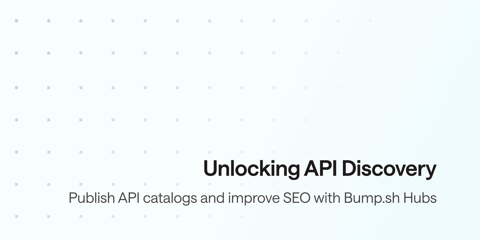Without documentation nobody knows an API exists or how to use it, so it’s worth investing the time in creating clear, useful, understandable documentation. This will help customers integrate with their applications quicker, cut down on support calls, and allow coworkers to onboard quicker as they join the company or move teams.
Fully documenting an API can be a long and difficult process, but new tools are always popping aiming to solve the problem in different ways. Some are open-source and some are Software-as-a-Service, some focus on beautiful interfaces, some focus on powerful functionality, and some focus on jamming AI all over the place.
There’s no one tool to rule them all, and different tools may be chosen depending on who is in charge of setting up the documentation (API developers, technical writers, governance teams) and the intended audience (public APIs, internal APIs, partner APIs).
There’s also the question of if this is for a single API or multiple APIs, whether or not other types of guides are supported (often via Markdown), and whether they support API discoverability through API catalogs to help customers pick between those various APIs or if you need to build that yourself.
To learn which documentation tools can be helpful for different scenarios, let’s compare the most popular OpenAPI documentation tools:
- Bump.sh
- Redoc
- Scalar
- Stoplight Elements
- ReadMe.io
Bump.sh
Bump.sh is a SaaS solution focused on building “Stripe-like” three column API reference documentation from OpenAPI and AsyncAPI documents from any source, using any workflow.
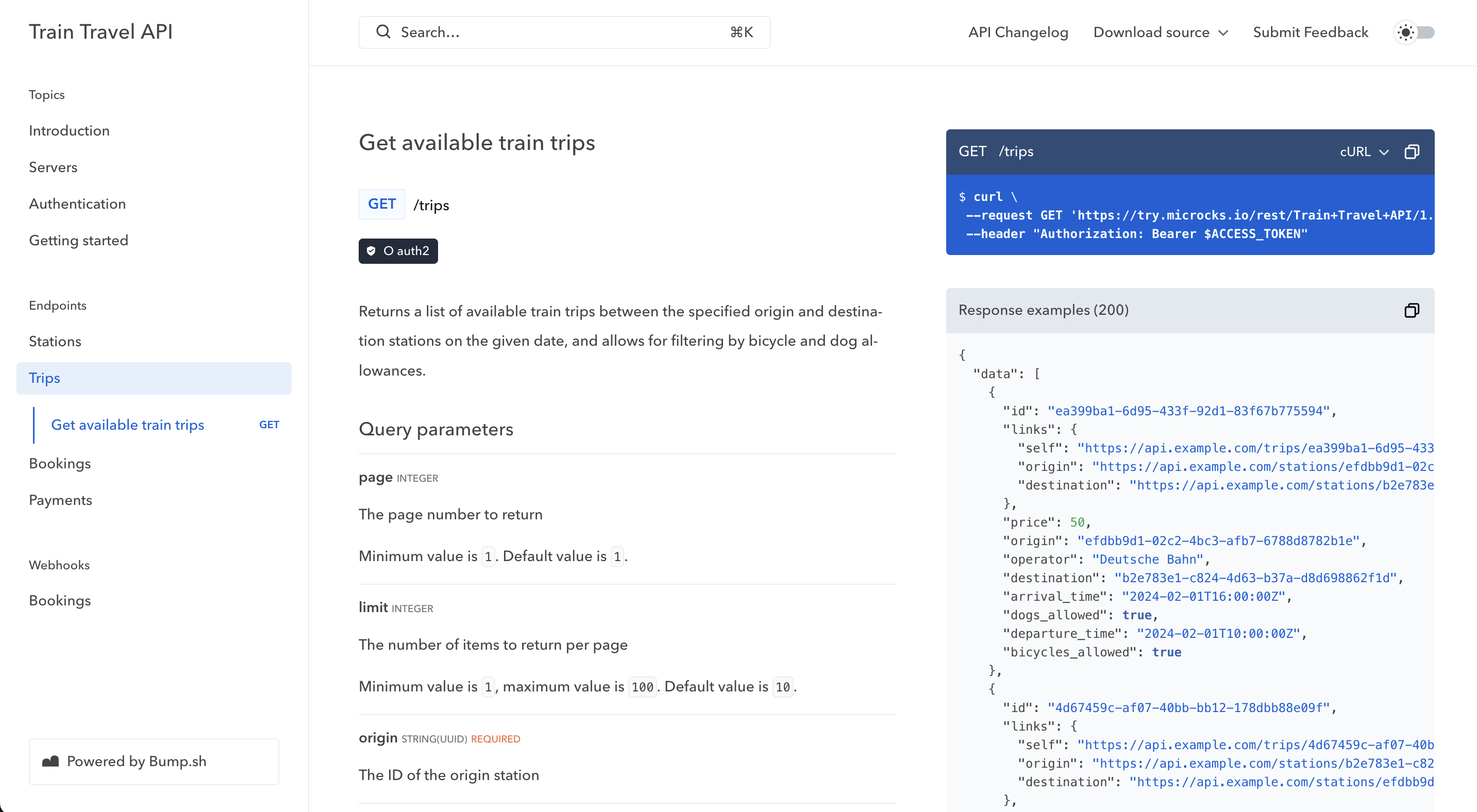
Bump.sh focuses on getting out of your way, staying clear of the “Walled Garden” approach others take. Instead of forcing everything to be done through a very specific way through a user interface, it integrates with existing Git/CI workflows, providing useful insight through their automatic changelog and breaking change detection in pull requests. It’s also one of the first few tools to support AsyncAPI as well as OpenAPI, allowing for event-driven APIs to be documented along side the usual REST/HTTP APIs.
API Catalogs are a strong feature known as Hubs, which allow for multiple APIs to be deployed from a variety of Git repos, or you can get creative with CI/CLI/API integrations to bring in API descriptions for anywhere. This is brilliant for large organizations trying to bring all their APIs into one place, even if teams have wildly different workflows, directory structures, design-first/code-first, spread around different GitHub/GitLab/Azure workspaces, and even allows for some older groups still using Subversion for some reason. This is the only tool compared which allows for this flexible approach to API catalogs. With different “Guests” able to view each Hub, this is brilliant for Partner APIs, especially as they can subscribe to API changes to be alerted of anything they need to know about directly.
The brand new API Explorer has brought powerful Try It functionality to documentation which people are coming to expect in all API docs, with a dedicated UI for building requests. This improves the UX compared to some competitors which try to handle this all through the main documentation view, because that gets pretty crowded when there are a lot of parameters to set on any given request. To avoid losing track of the docs, the try it allows them to pop up in a side pane, allowing for quick reference during request construction.
Multiple branches and versioning also make Bump.sh a great option for teams working on Public APIs where multiple versions of API documentation need to be maintained.
The team pride themselves on availability, and zero chatbots or automation between you and getting an answer from a friendly dedicated technical support staff member. They’re real people working on making real software and not trying to game anything with AI.
Bump.sh is free for 1 API, going up to €249/mo for multiple APIs, and an Enterprise option which focuses on tackling more complex needs and deep UI and UX integration into existing CMS’s using far more useful enterprise solutions than the usual JavaScript-widget approach.
Pros:
✅ Version control-focused API documentation.
✅ Blazing fast load times thanks to scanning OpenAPI / AsyncAPI changes and serving the results, instead of processing documents on-the-fly every time.
✅ SEO-friendly thanks to the pre-rendered crawlable documentation.
✅ Automatically detects and highlights API changes.
✅ Supports AsyncAPI, OpenAPI 3.1, 3.0 & 2.0, Webhooks, and Overlays.
✅ Enterprise: Can be run as <your-domain>.com/docs/* thanks to proxy support.
✅ Enterprise: Can be embedded with custom header/footer with server-side rendered content for maximum SEO/crawler-friendly docs.
Cons:
❌ Cloud hosted only, no self-hosted or open-source options.
❌ CSS maintenance is done by Bump.sh (no conventional customization/theming), yet brought a level higher with the Embedded mode.
Best for:
- CI/CD-focused teams integrating API documentation into DevOps workflows or docs-as-code workflows.
- Anyone trying to avoid being stuck in a walled garden. Your Git/CI is the source of truth.
- Teams working with complex API ecosystems, whether because multiple APIs, multiple API versions, many endpoints, deeply detailed objects, and/or fast evolving APIs.
- Tech reviewers eager for breaking change detection and API diffs to save them staring at a wall of potentially irrelevant YAML changes.
Redoc
Redoc is an old champion in the OpenAPI documentation world, built by Redocly to offer a beautiful “Stripe-like” two or three panel experience back when the only real choice was the less appealing Swagger UI.
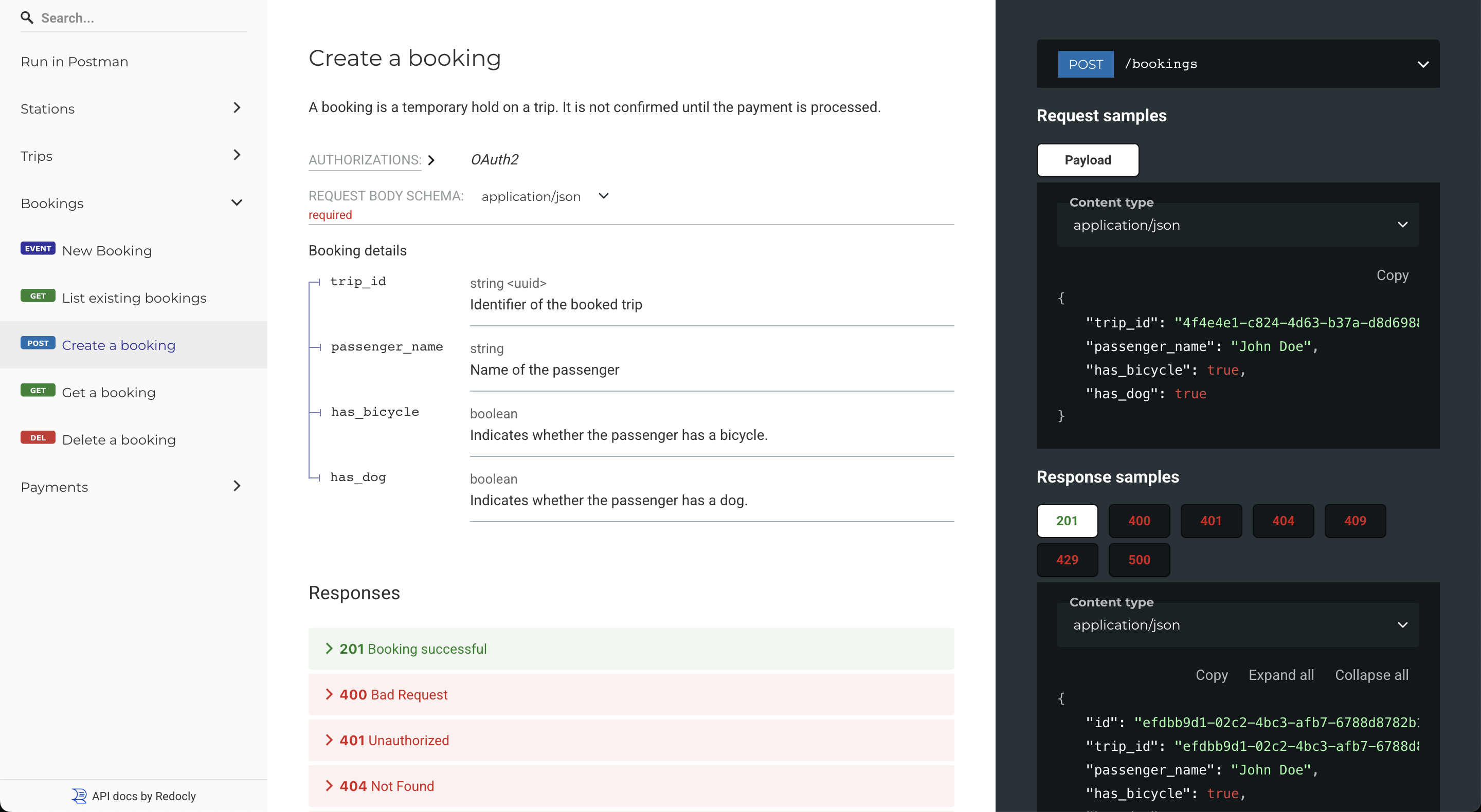
Redoc is also available as a self-hosted/open-source option, and a hosted version is available as part of a larger SaaS platform Realm.
Self-hosted Redoc only displays one API at a time, meaning anyone with multiple APIs is going to need to build their own developer experience hubs using CMS’, documentation tools, or custom coded solutions if they want coherent navigation between them all.
The hosted Redoc on the $10/month Pro allows for multiple APIs but only within a single project, which means work needs to be done to get multiple OpenAPI documents into that project instead of supporting multiple APIs in multiple sources.
The $24/month Enterprise plan comes with SSO for managing who can edit APIs, and “guest SSO” for hiding the resulting API documentation which is handy for partner APIs.
Pros:
✅ Highly customizable, professional-looking UI.
✅ Supports AsyncAPI, and OpenAPI 3.1, 3.0, and 2.0.
✅ Can be self-hosted or used as a cloud service.
✅ Includes “Try It” functionality on the cloud version.
✅ Provides API governance through the hosted version, and a handy linting and bundling CLI tool.
✅ Supports developer portal through Realm and Reunite SaaS products.
Cons:
❌ Requires some developer effort for customization.
❌ No Try It on the self-hosted version.
❌ Configuration is all done with YAML.
❌ Builds interface on-the-fly by reading an OpenAPI document so large APIs load slowly.
❌ Hosted version suffers very slow server-side rendering too.
❌ Only add one Guest SSO identity provider per organization making partner APIs for multiple organizations difficult.
Best for:
- Open-source API maintainers looking for a solid off-the-shelf open-source API documentation solution (self-hosted version).
- Teams who don’t mind writing some code to get highly customizable self-hosted API documentation, especially if trying to embed into existing CMS’ (self-hosted version).
- Publishing high quality reference documentation and guides for a single partner on an easily sharable link when no existing developer experience hubs exist (SaaS version).
Scalar
Scalar is made by developers, for developers, and you can tell. From the heavy focus on open-source tooling, to the dark-mode default with small text, and use of JetBrains Mono font, a quick glance at Scalar screams “programmers were here”.
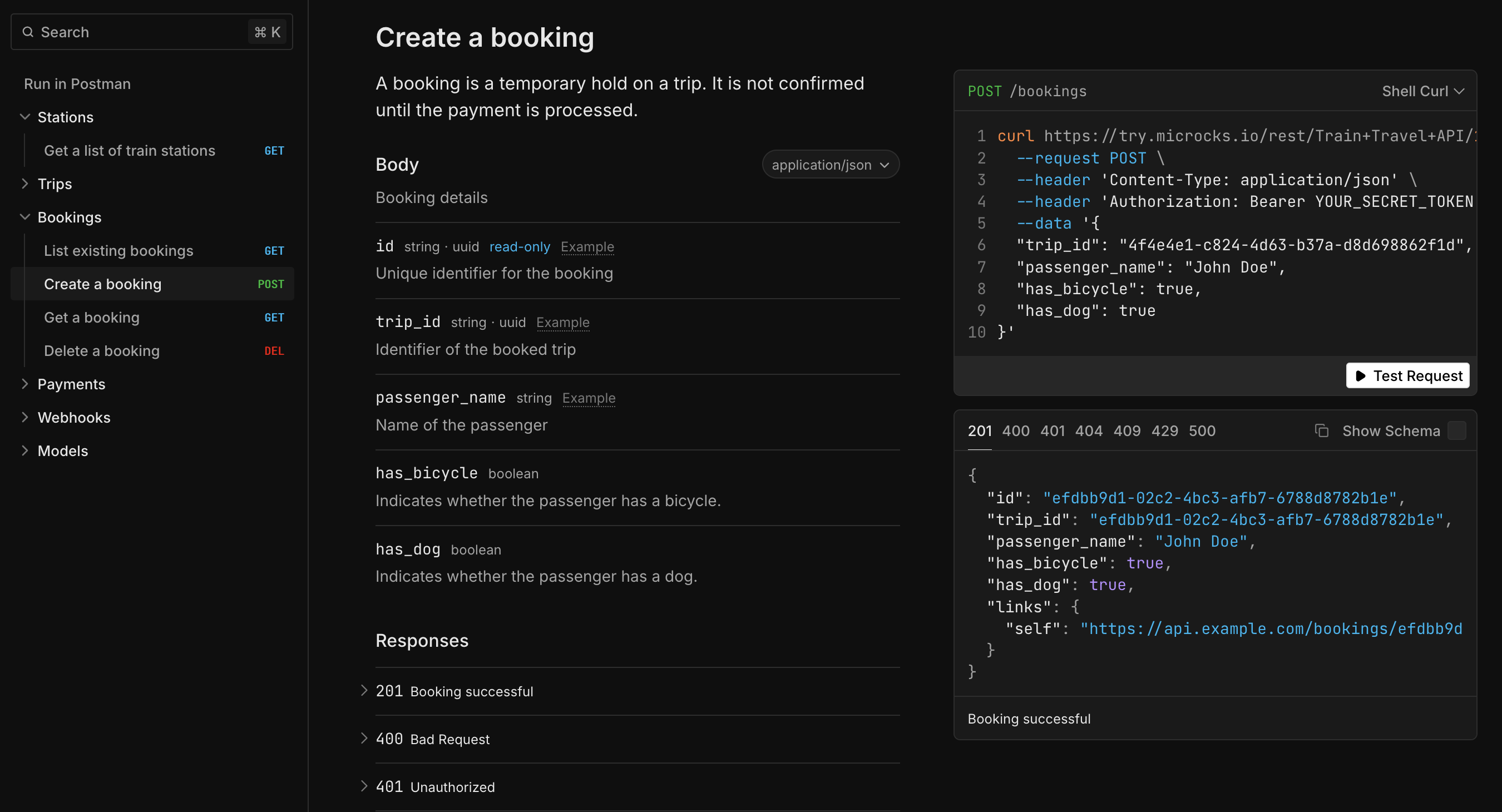
The toolsuite is very new, with a crux of their effort going into low-level open-source tooling to lay a groundwork for the rest of their tools to build upon. The nascent nature of their offering and their OSS focus doesn’t place them as a go-to solution for Enterprise customers who need more dedicated assistance, but their integration with open-source projects like Gitbook, Nitro, and Rust will make it a good choice for users of those tools.
Pros:
✅ A drop-in replacement for single developers and small teams switching away from SwaggerHub, replacing Swagger UI & Swagger Editor.
✅ Supports OpenAPI 3.1, 3.0, and 2.0.
✅ All versions of Scalar support a powerful Try It / API client.
✅ Cloud version has a built in text-based OpenAPI editor which handles small single-file OpenAPI documents.
✅ Supports guides as well as reference documentation.
Cons:
❌ Customization and theming focuses mostly on color schemes and custom CSS.
❌ Editor does not support external references.
❌ Doesn’t offer advanced API governance tools.
❌ Builds interface on-the-fly by reading an OpenAPI document so large APIs load slowly.
❌ Free SaaS only gets one user, then its $12/seat, with SSO behind a “Talk to the CEO” button.
❌ GitHub Sync only available on Pro, with no other way to deploy via CLI or CI/CD.
❌ Supports multiple APIs but no API Catalog / Dev Portal functionality.
Best for:
- Solo API developers who want a desktop HTTP client which happens to also produce API documentation.
- Open-source tools (e.g. web application frameworks, content management systems) which could themselves be self-hosted with an API and generate API endpoints / OpenAPI. Scalar would help turn that users generated OpenAPI into API documentation for their end-users without any SaaS involved.
Stoplight Elements
Stoplight Elements is a Web/React component that drops into existing documentation or open-source, allowing anyone to enjoy Stripe-like API documentation. It focuses on being as beautiful as possible, whilst still delivering the same functionality and covering the same use cases as Swagger UI. The tool was aiming to knock Swagger UI off the “top spot” years back, but active development has slowed to a crawl in a plume of irony after Swagger UI owners SmartBear bought Stoplight. It’s getting bug fixes and a handful of tweaky features, and development may well pick up again in the future, so it’s not out of the game just yet.
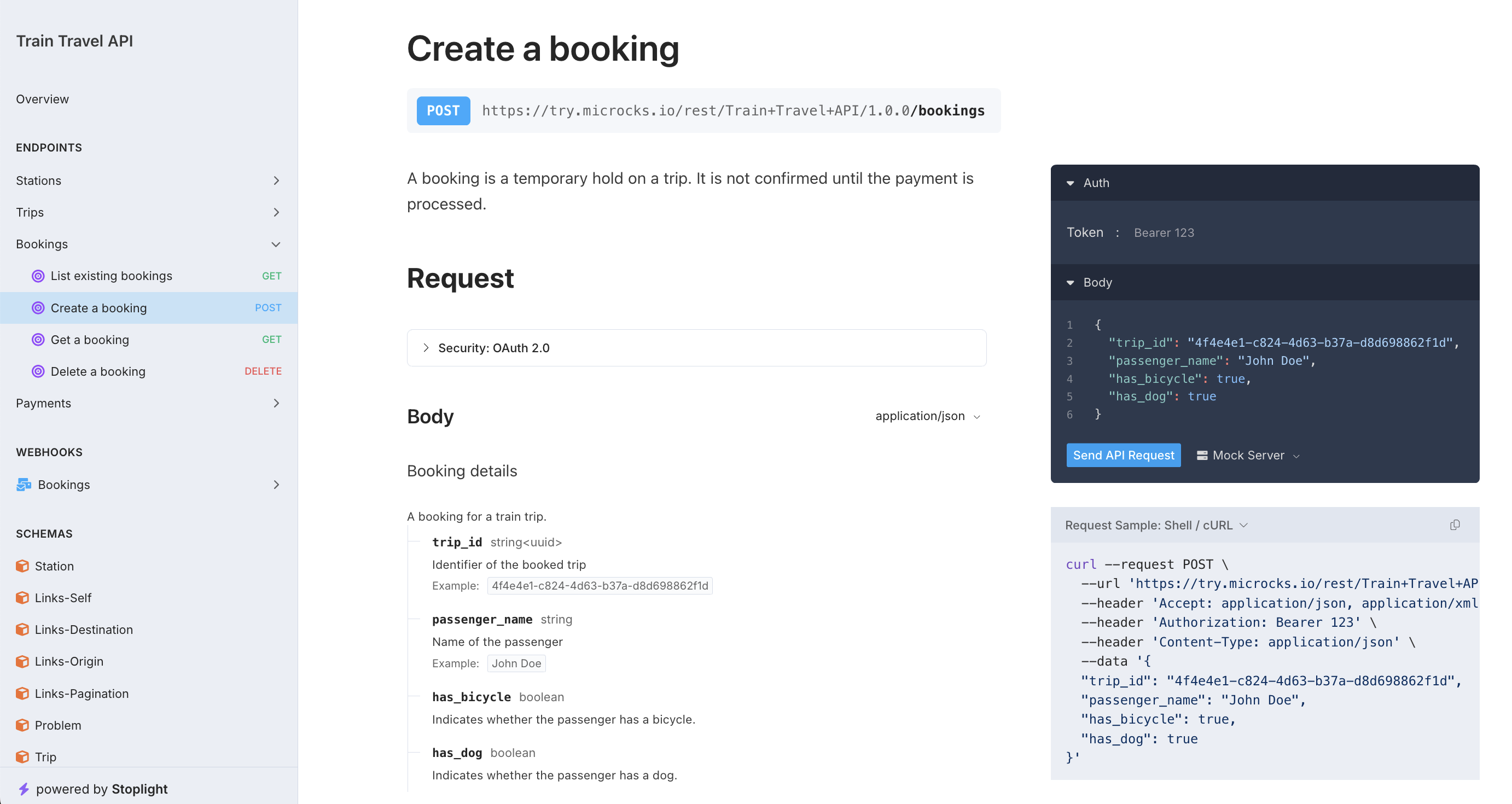
The self-hosted tool can take any OpenAPI document by URL or path, but can only handle one API at a time like most of the self-hosted tools. There is an extension called Elements DevPortal, which can handle multiple APIs and Markdown guides, but this assumes all the APIs are in the same Stoplight Platform “project”. It’s essentially a mini API Catalog, but the catalog cannot pull OpenAPI/Markdown content out of multiple projects or repos making the catalog functionality a little limited.
Pros:
✅ Beautiful, interactive documentation with Try-It functionality.
✅ Supports OpenAPI 3.1, 3.0, and 2.0.
✅ Easy integration into existing documentation or apps via Web/React components.
✅ Integrates with Stoplight Platform, a SaaS ecosystem which includes a GUI for API design, and API governance.
Cons:
❌ Limited out-of-the-box customization compared to Redocly.
❌ Confusing to get started for non technical users as it needs a web server and code to load the component.
❌ Stoplight’s full suite can be expensive, with unlimited APIs/projects but paying per user.
❌ Builds interface on-the-fly by reading an OpenAPI document so large APIs load slowly.
❌ No API catalog functionality.
Best for:
- Teams already using Stoplight for API design.
- Companies that prefer embedding documentation within existing apps.
ReadMe
ReadMe is a hosted developer portal which allows for API documentation in all forms, not just API reference documentation, but supports Markdown guides and even Recipes for documenting workflows and breaking down code samples.
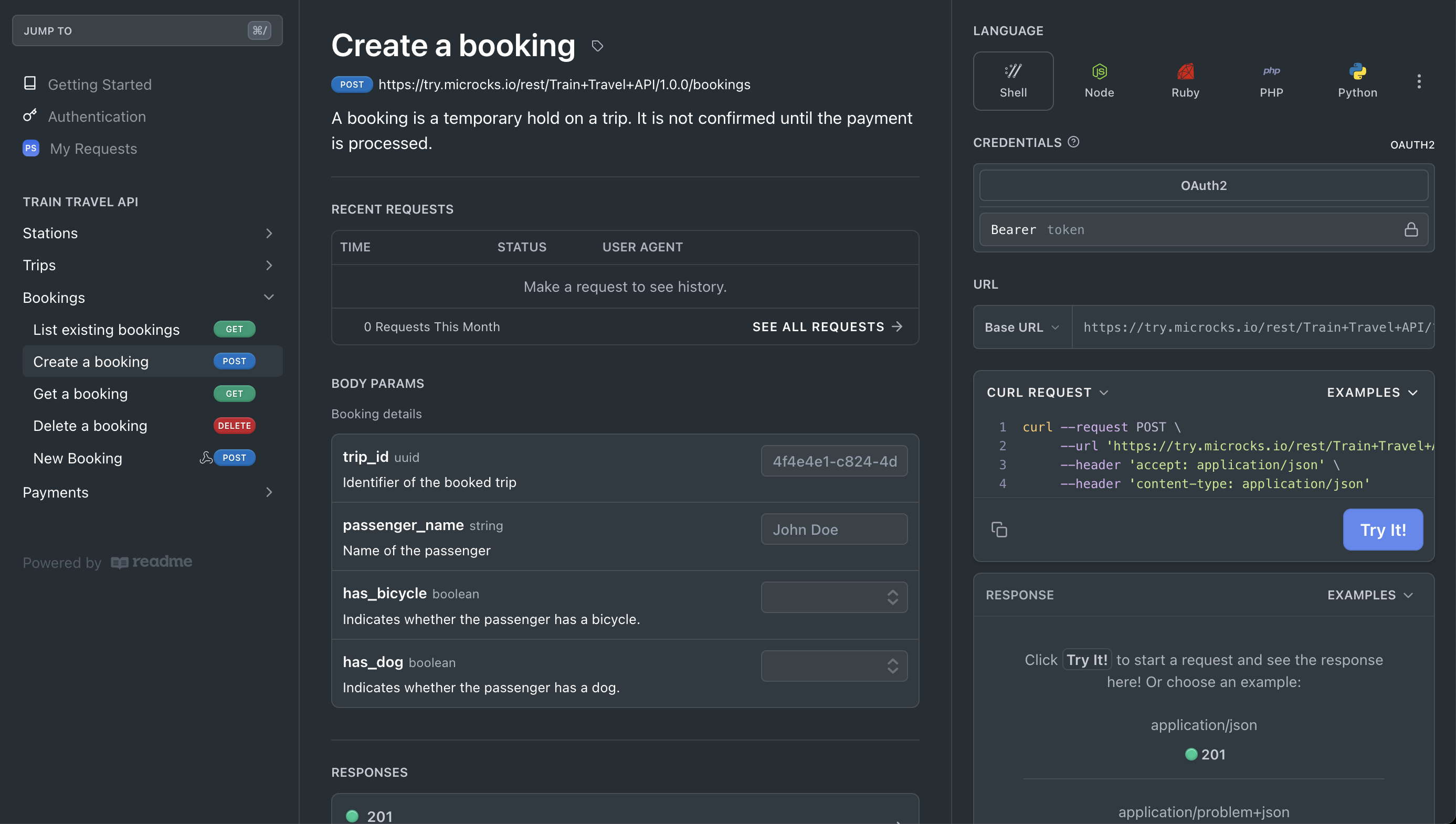
Instead of deploying changes from a Git repository or providing an editor to make changes directly, there is a two-way sync to merge in changes.
ReadMe is a strong pick for DevRel teams as it has built-in support for user feedback, a discussion forum, and tracks analytics. This can allow for data-driven improvements to the developer experience.
The pricing starts off ok for startups at $99/month, but ramps up quickly to $399/month for custom CSS/HTML. Extras send the price even higher, with $100/month for developer dashboards. and another $150/month to enable a ChatGPT-enabled “Owlbot” taking a punt at answering questions with what might even occasionally be correct answers sometimes.
Pros:
✅ Provides interactive API docs with an API explorer.
✅ Includes a developer portal with guides and tutorials.
✅ User feedback and discussions.
✅ Great for SaaS companies offering public APIs.
Cons:
❌ Pricing can be high for startups.
❌ Cloud hosted only, no self-hosted or open-source options.
❌ Less control over the doc styling compared to self-hosted solutions.
Best for:
- Teams that need API documentation and developer engagement tools.
- Businesses that want built-in analytics and API usage tracking.
Recommendations
So which is the best tool? As always “it depends”, so here are some quick pointers to help find the right tool for you.
When it comes to API docs, there’s no shortage of options, and no single right answer for every team.
If you care about performance and SEO Bump.sh is the right pick.
If you’re looking for a tool that fits cleanly into a modern, Git-based workflow, scales across multiple APIs and teams, and doesn’t lock you into yet another platform, Bump.sh has your back.
Bump.sh is built for engineers and tech writers who want docs to ship like code: fast, versioned, and CI-integrated. It handles the messy reality of modern API ecosystems (REST, event-driven, partners, multiple teams, multiple repos) and turns that into a clean, scalable developer experience.
